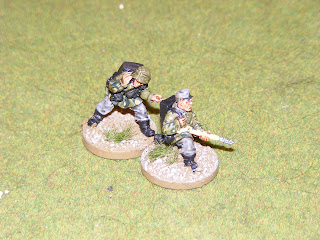Foam board, for those who do not know, is made from a piece of polystyrene with card attached to the flat sides. It can be drawn on like any other piece of card and cut with a simple craft knife. The material does have its limitations, such a requiring a water based adhesive such as PVA glue, but as modelling materials go it is versatile.
I decided to try out some prototyping for a village typical of one in Europe in the 1940's to suit the 'Bolt Action' battle reports that we will be filming in the new year on my YouTube channel 'wargamingforfun'.
Many village churches, especially in England and Wales, have a similar look to them and it was the look of the local church that I decided to base the idea on. I have simplified the design but I feel it is true to the original.
Using a piece of MDF measuring around 12' x 18' I cut and glued the church design with a small wall around the, what is soon to be, graveyard. I used a water-based contact adhesive to fix the pieces together rather than PVA glue as it has a much reduced drying time.
To hid the joint of the foam board I cut 2cm strips and scored down the middle to get a neat fold in the middle and then simply glued them to the corners of the building. For the roof joint I increased the card width to 3cm but the scoring method was still used to get a neat fold. A cereal box would be a suitable thickness of card for this process.
The rear door is a thin, approximately 1mm, piece of balsa wood in an arched door shape. The windows I marked with a permanent marker. I was careful to cut out the windows in one piece. I then glue the removed piece back into place but indented into the hole to give the 3D effect of the windows.
The wall sections were joined using 5mm balsa wood to represent wood posts.
The grave stones were made from cuts of some bits of blue foam, again stuck in place using the contact adhesive.
In order to make the walls appear more 'stonelike' I used some more pieces of blue foam cut into thin strips and glued into place. I then used a strip of glass/sand paper to round the edges.
This I repeated on top of the grave yard walls.
The porch/main entrance way into the church consists of three layers of foam board, the outer most having the archway shape cut into it. A card outline was used to disguise the joins.
Using PVA glue, and my washed building sand mix, I added 'soil' to the graveyard and left to dry over night.
After the paint scheme was left to dry I then fixed some larger bits of rubble to mark the edge of the pathway to the gate entrance. The clay colour that I used on the roof made the church too 'toy town' in appearance so I repainted the roof parts with pomegranate red.
Almost done with some static grass and arches in the windows to make the church appearance more complete. I think that I will revisit the model and use static grass around the border to help it blend on to the table top.


























